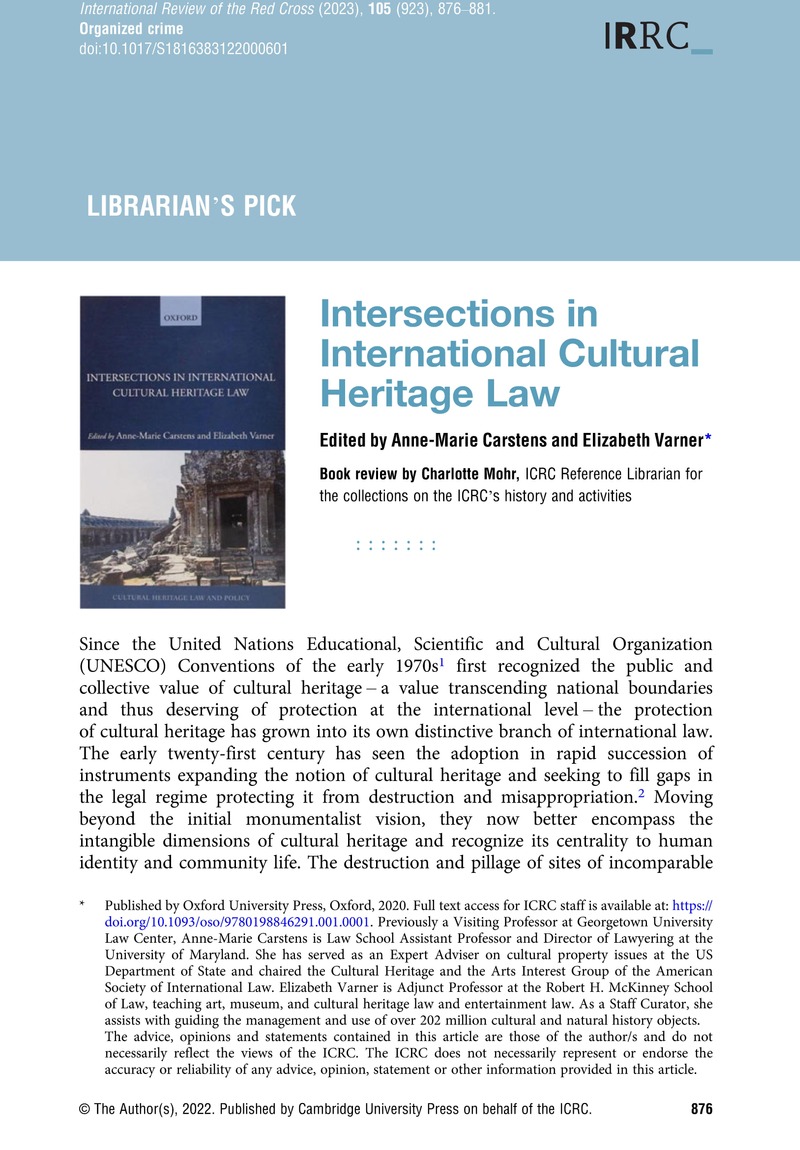No CrossRef data available.
Published online by Cambridge University Press: 17 October 2022

Published by Oxford University Press, Oxford, 2020. Full text access for ICRC staff is available at: https://doi.org/10.1093/oso/9780198846291.001.0001. Previously a Visiting Professor at Georgetown University Law Center, Anne-Marie Carstens is Law School Assistant Professor and Director of Lawyering at the University of Maryland. She has served as an Expert Adviser on cultural property issues at the US Department of State and chaired the Cultural Heritage and the Arts Interest Group of the American Society of International Law. Elizabeth Varner is Adjunct Professor at the Robert H. McKinney School of Law, teaching art, museum, and cultural heritage law and entertainment law. As a Staff Curator, she assists with guiding the management and use of over 202 million cultural and natural history objects.
The advice, opinions and statements contained in this article are those of the author/s and do not necessarily reflect the views of the ICRC. The ICRC does not necessarily represent or endorse the accuracy or reliability of any advice, opinion, statement or other information provided in this article.
1 Namely the 1970 Convention on the Means of Prohibiting and Preventing the Illicit Import, Export and Transfer of Ownership of Cultural Property and the 1972 Convention concerning the Protection of the World Cultural and Natural Heritage.
2 Most notably, the 2001 Convention on the Protection of the Underwater Cultural Heritage, the 2003 Convention for the Safeguarding of the Intangible Cultural Heritage and the 2005 Convention on the Protection and Promotion of the Diversity of Cultural Expressions.
3 Anne-Marie Carstens and Elizabeth Varner, “Intersections in Public International Law for Protecting Cultural Heritage Law: Past, Present, and Future”, in Intersections in International Cultural Heritage Law, p. 1.
4 Such as the acceptance of the 1954 Convention for the Protection of Cultural Property in the Event of Armed Conflict's applicability to situations of non-international armed conflict, which arguably smoothed the path to the adoption of Additional Protocol II to the 1949 Geneva Conventions.
5 Patty Gerstenblith, “The Disposition of Movable Cultural Heritage”, in Intersections in International Cultural Heritage Law.
6 The 1970 Convention on the Means of Prohibiting and Preventing the Illicit Import, Export and Transfer of Ownership of Cultural Property and the 1995 Convention on Stolen or Illegally Exported Cultural Objects.
7 Ahmad Al Faqi Al Mahdi, a leader within the Islamist armed group Ansar Eddine, was prosecuted in 2016 by the International Criminal Court for his role in the destruction of Timbuktu's historic mausoleums in 2012. He pleaded guilty, received a nine-years prison sentence and was ordered to pay reparations. Karolina Wierczyńska and Andrzej Jakubowski, “The Al Mahdi Case: From Punishing Perpetrators to Repairing Cultural Heritage Harm”, in Intersections in International Cultural Heritage Law.
8 Janet Blake, “Trafficking in Cultural Property: Where Cultural Heritage Law and the International Fight against Transnational Organized Crime Coincide”, in Intersections in International Cultural Heritage Law.
9 Kristin Hausler, “The UN Security Council, the Human Rights Council, and the Protection of Cultural Heritage: A Matter of Peace and Security, Human Rights, or Both?”, in Intersections in International Cultural Heritage Law.
10 Lucas Lixinski and Vassilis P. Tzevelekos, “The World Heritage Convention and the Law of State Responsibility: Promises and Pitfalls”, in Intersections in International Cultural Heritage Law.
11 Sarah Dromgoole, “The 2001 UNESCO Convention on the Protection of the Underwater Cultural Heritage and Its Principles Relating to the Recovery and Disposition of Material from Shipwrecks”, in Intersections in International Cultural Heritage Law.
12 Vanessa Tünsmeyer, “Bridging the Gap between International Human Rights and International Cultural Heritage Law Instruments: A Functions Approach”, in Intersections in International Cultural Heritage Law.
13 Robert Peters, “Nationalism versus Internationalism: New Perspectives beyond State Sovereignty and Territoriality in the Protection of Cultural Heritage”, in Intersections in International Cultural Heritage Law.